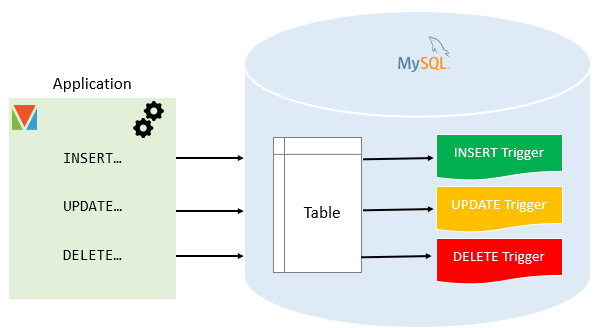In MySQL, a trigger is a stored program invoked automatically in response to an event such as insert, update, or delete that occurs in the associated table. For example, you can define a trigger that is invoked automatically before a new row is inserted into a table.
MySQL supports triggers that are invoked in response to the INSERT, UPDATE or DELETE event.
The SQL standard defines two types of triggers: row-level triggers and statement-level triggers.
- A row-level trigger is activated for each row that is inserted, updated, or deleted. For example, if a table has 100 rows inserted, updated, or deleted, the trigger is automatically invoked 100 times for the 100 rows affected.
- A statement-level trigger is executed once for each transaction regardless of how many rows are inserted, updated, or deleted.
MySQL supports only row-level triggers. It doesn’t support statement-level triggers.

Advantages of triggers
- Triggers provide another way to check the integrity of data.
- Triggers handle errors from the database layer.
- Triggers give an alternative way to run scheduled tasks. By using triggers, you don’t have to wait for the scheduled events to run because the triggers are invoked automatically before or after a change is made to the data in a table.
- Triggers can be useful for auditing the data changes in tables.
Disadvantages of triggers
- Triggers can only provide extended validations, not all validations. For simple validations, you can use the
NOT NULL,UNIQUE,CHECKandFOREIGN KEYconstraints. - Triggers can be difficult to troubleshoot because they execute automatically in the database, which may not be visible to the client applications.
- Triggers may increase the overhead of the MySQL server.
Managing MySQL triggers
- Create triggers – describe steps of how to create a trigger in MySQL.
- Drop triggers – show you how to drop a trigger.
- Create a BEFORE INSERT trigger – show you how to create a
BEFORE INSERTtrigger to maintain a summary table from another table. - Create an AFTER INSERT trigger – describe how to create an
AFTER INSERTtrigger to insert data into a table after inserting data into another table. - Create a BEFORE UPDATE trigger – learn how to create a
BEFORE UPDATEtrigger that validates data before it is updated to the table. - Create an AFTER UPDATE trigger – show you how to create an
AFTER UPDATEtrigger to log the changes of data in a table. - Create a BEFORE DELETE trigger – show how to create a
BEFORE DELETEtrigger. - Create an AFTER DELETE trigger – describe how to create an
AFTER DELETEtrigger. - Create multiple triggers for a table that has the same trigger event and time – MySQL 8.0 allows you to define multiple triggers for a table that has the same trigger event and time.
- Show triggers – list triggers in a database, table by specific patterns.